
OER Article
- Subject:
- Applied Science
- Health, Medicine and Nursing
- Material Type:
- Reading
- Author:
- Occupational Safety and Health Administration
- Date Added:
- 01/27/2022

OER Article
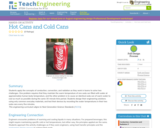
Students apply the concepts of conduction, convection and radiation as they work in teams to solve two challenges. One problem requires that they maintain the warm temperature of one soda can filled with water at approximately human body temperature, and the other problem is to cause an identical soda can of warm water to cool as much as possible during the same 30-minute time period. Students design their engineering solutions using only common everyday materials, and test their devices by recording the water temperatures in their two soda cans every five minutes.
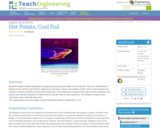
Students explore material properties by applying some basic principles of heat transfer. They use calorimeters to determine the specific heat of three substances: aluminum, copper and another of their choice. Each substance is cooled in a freezer and then placed in the calorimeter. The temperature change of the water and the substance are used in heat transfer equations to determine the specific heat of each substance. The students compare their calculated values with tabulated data.
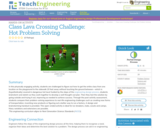
Student teams follow the steps of the engineering design process to meet the challenge of getting their entire class from one location on the playground to the sidewalk without touching the ground between. The class develops a well thought-out plan while following the steps of the engineering design process. Then, they test their solution by going outside and trying it out. Through the post-activity assessment, they compare their problem-solving experience to real life engineering challenges, such as creating new forms of transportation or new product invention.
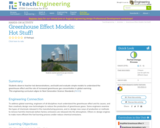
Students observe demonstrations, and build and evaluate simple models to understand the greenhouse effect and the role of increased greenhouse gas concentration in global warming.
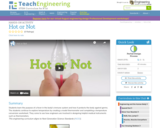
Students learn the purpose of a fever in the body's immune system and how it protects the body against germs. The students continue to explore temperature by creating a model thermometer and completing a temperature conversion worksheet. They come to see how engineers are involved in designing helpful medical instruments such as thermometers.
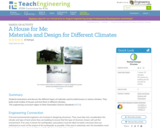
Students brainstorm and discuss the different types of materials used to build houses in various climates. They build small models of houses and test them in different climates.
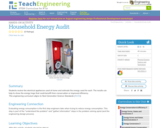
Students review the electrical appliances used at home and estimate the energy used for each. The results can help to show the energy hogs that could benefit from conservation or improved efficiency.
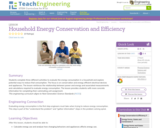
Students complete three different activities to evaluate the energy consumption in a household and explore potential ways to reduce that consumption. The focus is on conservation and energy efficient electrical devices and appliances. The lesson reinforces the relationship between power and energy and associated measurements and calculations required to evaluate energy consumption. The lesson provides the students with more concrete information for completing their culminating unit assignment.
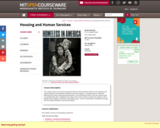
Focuses on how the housing and human service systems interact: how networks and social capital can build between elements of the two systems. Explores ways in which the differing world views, professional perspectives, and institutional needs of the two systems play out operationally. Part I establishes the nature of the action frames of these two systems. Part II applies these insights to particular vulnerable groups: "at risk" households in transitional housing, the chronically mentally ill, and the frail elderly.
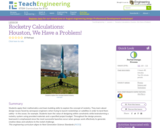
Students apply their mathematics and team building skills to explore the concept of rocketry. They learn about design issues faced by aerospace engineers when trying to launch rocketships or satellites in order to land them safely in the ocean, for example. Students learn the value of designing within constraints while brainstorming a rocketry system using provided materials and a specified project budget. Throughout the design process, teamwork is emphasized since the most successful launches occur when groups work effectively to generate creative ideas and solutions to the rocket challenge.
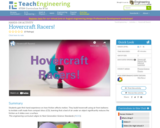
Students gain first-hand experience on how friction affects motion. They build a hovercraft using air from a balloon to levitate a craft made from a compact disc (CD), learning that a bed of air under an object significantly reduces the friction as it slides over a surface.

Students are introduced to a challenge question. Towards answering the question, they generate ideas for what they need to know about medicines and how they move through our bodies, watch a few short videos to gain multiple perspectives, and then learn lecture material to obtain a basic understanding of how antibiotics kill bacteria in the human body. They learn why different forms of medicine (pill, liquid or shot) get into the blood stream at different speeds.
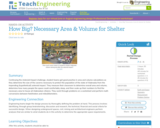
Students teams determine the size of the caverns necessary to house the population of the state of Alabraska from the impending asteroid impact. They measure their classroom to determine area and volume, determine how many people the space could sleep, and scale this number up to accommodate all Alabraskans. They work through problems on a worksheet and perform math conversions between feet/meters and miles/kilometers.
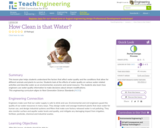
This lesson plan helps students understand the factors that affect water quality and the conditions that allow for different animals and plants to survive. Students will look at the effects of water quality on various water-related activities and describe water as an environmental, economic and social resource. The students will also learn how engineers use water quality information to make decisions about stream modifications.
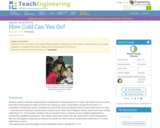
Students explore materials engineering by modifying the material properties of water. Specifically, they use salt to lower the freezing point of water and test it by making ice cream. Using either a simple thermometer or a mechatronic temperature sensor, students learn about the lower temperature limit at which liquid water can exist such that even if placed in contact with a material much colder than 0 degrees Celsius, liquid water does not get colder than 0 °C. This provides students with an example of how materials can be modified (engineered) to change their equilibrium properties. They observe that when mixed with salt, liquid water's lower temperature limit can be dropped. Using salt-ice mixtures to cool the ice cream mixes to temperatures lower than 0 °C works better than ice alone.
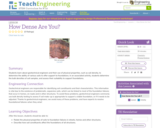
Students learn about geotechnical engineers and their use of physical properties, such as soil density, to determine the ability of various soils to offer support to foundations. In an associated activity, students determine the bulk densities of soil samples, and assess their suitability to support foundations.
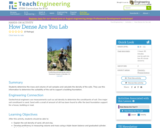
Students determine the mass and volume of soil samples and calculate the density of the soils. They use this information to determine the suitability of the soil to support a building foundation.
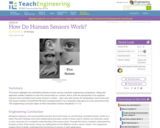
This lesson highlights the similarities between human sensors and their engineering counterparts. Taking this approach enables students to view the human body as a system, that is, from the perspective of an engineer. Humans have recreated most human sensors in robots – eyes, ears and sensors for temperature, touch and smell. The lesson inculdes a PowerPoint file that is programmed to run a Jeopardy-style game as a fun assessment tool.
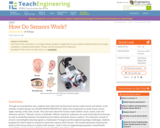
Through six lesson/activity sets, students learn about the functioning of sensors, both human and robotic. In the activities, student groups use LEGO MINDSTORMS(TM) NXT robots and components to study human senses (sight, hearing, smell, taste, touch) in more detail than in previous units in the series. They also learn about the human made rotation, touch, sound, light and ultrasonic sensors. "Stimulus-sensor-coordinator-effector-response" pathways are used to describe the processes as well as similarities between human/animal and robotic equivalent sensory systems. The important concept of sensors converting/transducing signals is emphasized. Through assorted engineering design challenges, students program the LEGO robots to respond to input from various LEGO sensors. The overall framework reinforces the theme of the human body as a system with sensors that is, from an engineering perspective. PowerPoint® presentations, quizzes and worksheets are provided throughout the unit.